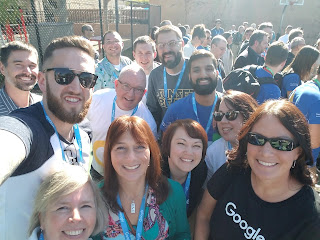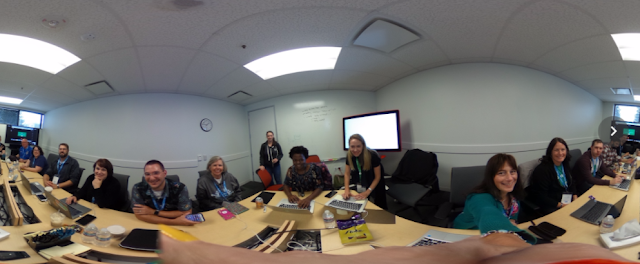The stage at the Top Contributor Summit in Mountain View, California.
Being a Top Contributor in the G Suite for Education help forum is an accomplishment that I am very proud of. When I first started to contribute in the forum, I just wanted to help people with their issues. I figured, let me answer some questions because I knew my response was correct. As I continued to help people, my rank in the forum advanced and it didn't take long for me to be addicted to it. Last year, I made Top Contributor status and this year, I was invited to attend the Top Contributor Summit in Mountain View, California. To sum up my experience, it was absolutely incredible!!!!

The team of people I work with are wonderful. We are all educators and Googlers who are passionate and dedicated to help our users in the forum. Many of us traveled to Mountain View from different areas of North America, but Graham was the furthest from England. It was great to finally meet everyone face to face. As a team, we are committed to the forum, passionate, and have one thing in common, to help the end user. The G Suite for Education forum supports all educational issues in G Suite, which includes all Google apps, Google Classroom, Expeditions, and Forms.
On the first day of the summit, all of the Top Contributors gathered in one room. People came from around the world to attend the summit. Although many did not speak fluent English, everyone had one thing in common, their passion of Google and to help the end user.
Another thing we had in common was music. The opening presenter organized everyone by the color of the plastic tube that was left on everyone's chair. Everyone had a different color tube and a different beat to follow. By the end of the exercise, the entire audience was in sync. So that's how Google, the tech giant, engages their audience! It was amazing!
Dashini Jeyathurai who is a Knowledge Manager, Global Vendor Operations, YouTube expert.
All of the presenters spoke about their expertise in their product and some even provided a demonstration. Some items that were displayed were the Pixelbook, and the Google Assistant. Additionally, the presenters left time for the audience to ask questions or provide feedback on their products.
I was so happy to hear the presenter speak about machine learning. Google is going to continue and enhance machine learning in their apps. Their goal is to have their apps be so smart that it will know your habits and what you are thinking. I was amazed by this because this aspect is a huge part of Computer Science. So, I decided to ask the presenter a question, and represent the educators and students who can benefit from this concept in schools, K-12.

On the second day of the summit, my team was assigned to learn about Google Drive and Docs. We were in a small group with the Google Play team, as well as the community managers from each team. We were informed on product updates on Google Drive, Docs, Sheets, and Sites. In the afternoon, my team went into a conference room in a different building and collaborated with the community managers for G Suite for Education. We spoke about our team vision and goals, product updates, provided feedback and even experimented with Jamboard. For me, this day was invaluable. Being able to build relationships and a team vision with people who have a common passion is priceless!
Overall, my experience in attending my first Top Contributor Summit was awesome and memorable. I enjoyed all of the conversations I had with many people, and I especially learned a lot. The group of people on the G Suite for Education team are awesome! I am so thankful to be a part of this community.
A few shout-outs: Thank you Aditya, Anita, Evan, and Lauren for allowing me to be a part of this community. I am truly honored and proud to be on this team. I learn so much from everyone on the team. Thank you Fred to mentoring me and answering all of my questions. Thank you to all of the people who organized this summit! Most of all, thank you to my husband for always supporting me. It was truly amazing!
Here is a photo collage of the many people I met and some other interested icons.








































